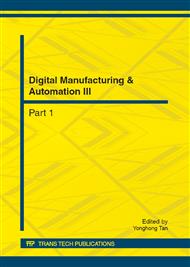p.801
p.806
p.813
p.819
p.825
p.832
p.836
p.842
p.847
Simulation Analysis of the Vibration Characteristics of the Parallel Hybrid Shaft System
Abstract:
Abstract. The multi-body dynamics simulation model of the hybrid system with a flexible shaft was established through rationally simplifying the system structure of a parallel hybrid system, assembling the flexible shaft, pulley, piston assembly , rod assembly and the rotor shaft according to the actual constraints, and adding the appropriate connections. The engine cylinder pressure reconstruction model and the motor vector control model were established in MATLAB as system shafting incentives. The simulation analysis of the dynamic characteristics of the system shafting was carried out in the boost mode of the hybrid system. The results show that: the shaft torsional vibration and bending vibration have happened when the hybrid system is running, and the engine cylinder pressure change was the main factor which caused the shaft vibration. Torsional vibration occurs mainly near the even multiple of the frequency of the shaft rotational frequency, and the torsional amplitude decreases gradually with the increase of resonance frequency; radial vibration occurs mainly in the range of 0 to 3 times the rotational frequency.
Info:
Periodical:
Pages:
825-831
Citation:
Online since:
July 2012
Authors:
Keywords:
Price:
Сopyright:
© 2012 Trans Tech Publications Ltd. All Rights Reserved
Share:
Citation:


